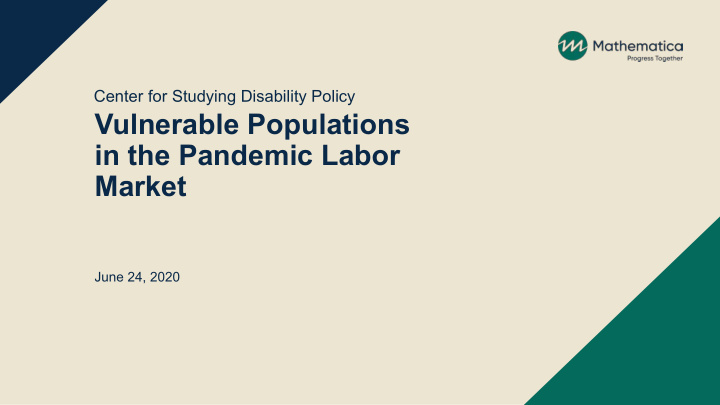



Center for Studying Disability Policy Vulnerable Populations in the Pandemic Labor Market June 24, 2020
Welcome Center for Studying Disability Policy 2
Speakers Teresa Purvi Sevak Ghilarducci Mathematica The New School for Social Research Kelly Pavich David Bridges from Wittenburg School to Work Mathematica Center for Studying Disability Policy 3
National statistics on some vulnerable groups Purvi Sevak Mathematica Center for Studying Disability Policy 4
Employment rate among people with and without disabilities Center for Studying Disability Policy 5
Unemployment rate higher among workers with disabilities Note: April 2020 unemployment rates (not seasonally adjusted). Source: Bureau of Labor Statistics. Center for Studying Disability Policy 6
Unemployment rates higher among Black and Hispanic workers Note: April 2020 unemployment rates (not seasonally adjusted). Source: Bureau of Labor Statistics. Center for Studying Disability Policy 7
Unemployment rate highest among youth Note: April 2020 unemployment rates (not seasonally adjusted). Source: Bureau of Labor Statistics. Center for Studying Disability Policy 8
How COVID-19 Harshly Affects Older Workers Teresa Ghilarducci The New School Schwarz Center for Economic Policy Analysis Retirement Equity Lab Center for Studying Disability Policy 9
Even before the pandemic, Americans worked longer and died younger than elders in other advanced countries 10
12 million of the 29 million middle-class older workers will be downwardly mobile in retirement 11
During past recessions, including the Great Recession, older workers were LESS likely to become unemployed than younger workers Source: Johnson, R. “Older Workers and COVID-19: The Harsh Economic Realities.” 12
That has changed during this pandemic for nearly all demographic groups of middle-aged and older workers. Source: Johnson, R. “Older Workers and COVID-19: The Harsh Economic Realities.” 13
Evidence from one promising program Kelly Pavich Bridges from School to Work Center for Studying Disability Policy 14
Br Bridges f s from om Assist special education individuals ages 17 to 24 find integrated, competitive employment School ool t to W o Wor ork: -12 urban areas, mostly Title I schools Transforming lives through the power of Provide one-on-one support to participants as they transition to adulthood a job -Job readiness training -Assistance with job development and employment -Up to a year of post-hire date support In a typical program year: -About 1,000 participants -88% placement rate -80% working at 90 days 15
COV OVID-19 a and e employment of Bridges participants • Enrolled: 742 youth in program year 2020 • 717 (97%) still engaged • Hired: 569 (77%) in employment • 195 (34%) still working • 154 (27%) seeking work • Participants affected by COVID-19: • Family members ill or died • Furloughed, or members of their families were furloughed or laid off 16
How i is B Bridges k keeping 9 g 97% of pa participants e eng ngaged ed? • Support from staff to complete remote learning in school year • Virtual employability skills instruction • 1,000+ registered for summer course in New York City • Partnered with Accenture to offer Skills to Succeed (S2S) and a Boot Camp event • 141 online career courses • 6 weekly events via Zoom 17
Questions? Center for Studying Disability Policy 18
For more information: Purvi Sevak psevak@mathematica-mpr.com Teresa Ghilarducci ghilardt@newschool.edu Kelly Pavich kelly.pavich@bridgestowork.org Center for Studying Disability Policy 19
Thank you! Center for Studying Disability Policy
Recommend
More recommend